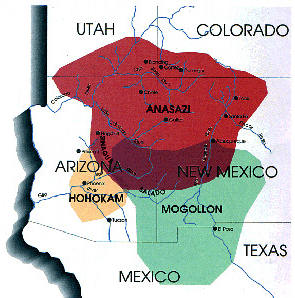 ClayHound Web
- Hohokam
Pottery
ClayHound Web
- Hohokam
PotteryReturn to:
|
HOHOKAM POTTERY |
|||||||||||
Hohokam CultureThe Hohokam is known primarily from the "core area" of the Phoenix
and Tucson basins, where perennial water sources were available. Known
as the Masters of the Desert, the Hohokam developed massive irrigation
systems consisting of hundreds of miles of canals. Some large villages
contained ballcourts and The Goldwater Range is located in the Papagueria, an area that extends from the Avra Valley west of Tucson to the Colorado River, from northern Mexico to an area just south of Gila Bend. Archeologists consider this area to have been peripheral to the Hohokam core, and was traversed by the Hohokam on shell gathering expeditions to the Sea of Cortez. As Hohokam population expanded to the west, large villages appeared in eastern and northern Papagueria where shells were manufactured into ornaments for trade with others. Some villages in the northern Santa Rosa Valley included water reservoirs. Different regions produced distinct patterns of pottery, such as Sells Red (from eastern Papagueria), Phoenix basin red-on-buff and Tucson basin red-on-brown ceramics. Archaeological survey data from Organ Pipe Cactus National Monument indicate major changes in Hohokam settlement during the Classic period (A.D. 1150-1450). The majority of the 80 Hohokam sites recorded date to the Classic period, indicating continued expansion or growth of populations in western Papagueria. Hohokam sites are found for the first time on the bajada. These artifact scatters with roasting pits reflect resource procurement, processing, and preparation of plants and animals found on the bajada. Previously-established villages expanded with the addition of reservoirs. New villages, at least one with a canal, were established. Tanque Verde Red-on-brown became the dominant ceramic type along with Sells Red throughout the Classic period. A new currently unnamed Redware that may have been manufactured in the Organ Pipe area appeared for the first time. Late Classic period sites include the addition of Salado polychromes. The occurrence of Tucson basin ceramics indicates a shift either in political alliances or exchange networks from the Phoenix basin to the Tucson basin. Large Classic period villages with reservoirs became increasingly
common
The Hohokam culture suffered a series of setbacks in the 1400s. A massive flood of the Salt River destroyed large areas and canal networks, and warfare between various groups resulted in destruction of the great houses of the Salt and Gila River valleys. The Hohokam people dispersed to various areas, and are claimed as the ancestors of various other tribes, including the Hopi and O'odham. The large villages were abandoned in favor of smaller, isolated settlements, and the remaining Hohokam were assimilated into other groups. When Spanish explorers arrived 200 years later, they encountered several O'odham and other groups. When asked by the Spaniards who built the abandoned great houses and villages, the answer was "Hohokam," meaning those who lived here before and are "all used up." http://www.luke.af.mil/rmo/pre.htm |
|||||||||||
|
Excellent information from the Logan Museum of Anthropology on line from Beloit, Wisconsin |
|||||||||||
|
All text and images are used courtesy
of the Logan Museum of Anthropology, Beloit College |
|||||||||||
|
|
|||||||||||
|
Hohokam culture was not widespread and thus pottery was relatively homogeneous. All Hohokam utility pottery is therefore categorized as Pimeria Brown Ware and all painted types as Hohokam Buff Ware. Pimeria Brown Ware Hohokam utility pottery is categorized as Pimeria Brown Ware.
Material: The clay is gray to brown and is characteristically
tempered with mica flakes, giving the surface of vessels a glittery
aspect.
Hohokam Buff Ware Hohokam painted pottery is categorized as Hohokam Buff Ware
Material: The clay is characteristically tempered with mica
flakes, giving the surface of vessels a glittery aspect.
From: http://www.beloit.edu/~museum/logan/southwest/hohokam/hohokam.htm |
|||||||||||
|
Today's Descendants of the Hohokam: |
|||||||||||
|
|
|
||||||||||
 platform mounds. The Casa Grande Ruins
National Monument provides an example of the entire Hohokam temporal
sequence.
platform mounds. The Casa Grande Ruins
National Monument provides an example of the entire Hohokam temporal
sequence. in this most arid portion of Papagueria. In an area where
permanent water supplies were almost nonexistent, reservoirs provided
a stable source of water which enabled year-round occupation. These
reservoirs did not merely collect water from the surrounding surface--
they were wells dug to intercept the shallow groundwater. Some
villages had canals which diverted and allocated water. Excavation and
maintenance of the reservoir required organized labor, which in turn
required a centralization of authority.
in this most arid portion of Papagueria. In an area where
permanent water supplies were almost nonexistent, reservoirs provided
a stable source of water which enabled year-round occupation. These
reservoirs did not merely collect water from the surrounding surface--
they were wells dug to intercept the shallow groundwater. Some
villages had canals which diverted and allocated water. Excavation and
maintenance of the reservoir required organized labor, which in turn
required a centralization of authority.


